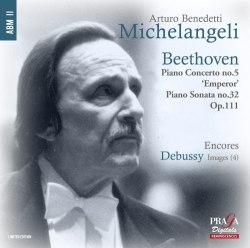|

|
Ludwig van BEETHOVEN (1770-1827)
Piano sonata No.32 in C minor, Op.111 (1822) [25:18]
Piano Concerto No.5 in E flat major, Op.73 Emperor (1809) [36:48]
Claude DEBUSSY (1862-1918)
Images Book I (1905): Reflets dans l’eau [3:59]; Hommage à Rameau [6:08]
Images Book II (1907): Cloches à travers les feuilles [3:24]; Et la lune descend sur le temple qui fut [4:49]
Arturo Benedetti Michelangeli (piano)
Prague Symphony Orchestra (FOK)/Václav Smetáček
rec. May 1961, London (Sonata); May 1957, Smetana Hall, Prague (Concerto) and March 1957, London (Debussy)
PRAGA DIGITALS PRD/DSD 350 098 SACD [79:01]
This is partly a reissue of Praga PR 250 021, which was released back in 1993. It serves now as a further example of the company’s devotion to Michelangeli, given that a Ravel-and-Debussy disc (350091) has already been released.
The centrepiece of the programming is the Emperor Concerto performance given at the 1957 Prague Spring. The location was not the Rudolfinum but the Smetana Hall and the date was 29 May. There’s a magnificent coffee table-sized book about Prague Springs down the years and I’m fortunate to have a copy. I looked up the local view of the pianist and critical opinion then bracketed Michelangeli with Richter and Horowitz. Clearly he left a sizeable impression. Many years later he teamed with Celibidache - now that really is a meeting of individuals - for a reading that some rate highly. As far as I’m concerned this Prague performance is Michelangeli all the way, with Smetáček very much a back-seat driver, very much the ‘star fiddler’s accompanist’. Michelangeli’s blend of glacial imperturbability, phrasal rapidity and rubato extremes create a frisson of instability at the keyboard. The recording, and indeed the playing, are treble orientated and there’s a milking of phrases that reflects poorly on the pianist. Detailing in the winds is glossed, or else the recording doesn’t pick it up. The slow movement is aristocratically brisk; some would say that, at this tempo, it’s less brisk than brusque. Rhetorical pauses blight a passage or two in the finale, but it all generates excited applause. Clearly there was a vivid visual and musical impression being made.
The profound challenge of the Op.111 sonata was met in London in May 1961. Having auditioned once again Maria Yudina’s highly sculpted, earlier, studio recording of this sonata - knotty, idiosyncratic - it strikes me that its antipode is something like this Michelangeli performance. There’s a haughty clarity, a digital precision that doesn’t remain wedded to any particular expressive insight. The result is magnificent in its way, but it’s more anatomy than interpretation. As for the remainder, these are what Praga calls ‘encores’. We get four pieces; two from each book, from Images, recorded live in London in March 1957. One should naturally put aside Debussians such as Gieseking and indeed Daniel Ericourt. One should in fact put to one side, to a degree, Michelangeli himself who shows, in his Helsinki performances in 1969 and at the Vatican in 1987 - where there is overlap in the pieces performed - a very changeable approach indeed. The Vatican ones are very much slower than those in London. The Helsinki ones - given only twelve years after the London ones - are even more so. The differences are remarkable. The concert preserves a sonority that is crisp, and quite harsh, and interpretations that are chiselled from ice.
I appreciate that these are fairly commonplace reflections on Michelangeli in this repertoire, but it’s hard to think what else constructively to say. It’s beyond instructive to listen to these performances - the process provides one startling moment after another, in terms of chordal balance, colour, phrasing, pedalling - but it gets progressively less easy to enjoy them. The re-mastering and notes are reasonably good.
Jonathan Woolf
Masterwork Index: Beethoven piano concerto 5 ~~ Piano sonata 32
 |
 |
|
